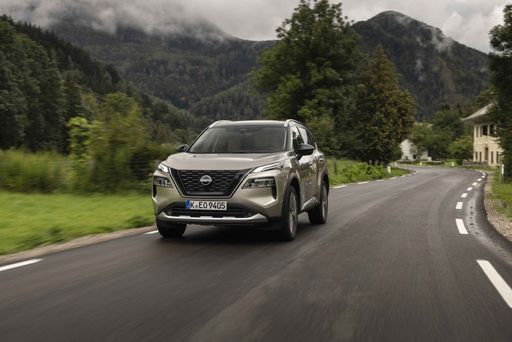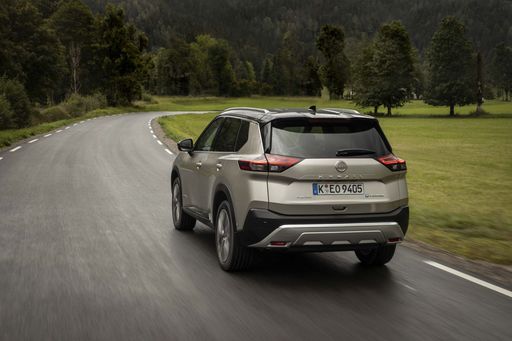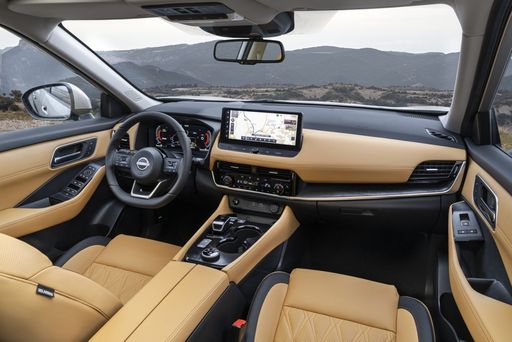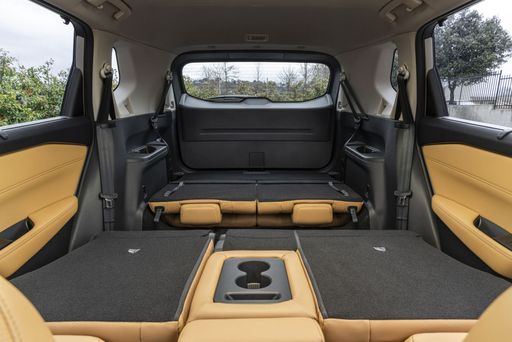Nissan X-Trail vs VW Transporter Transporter – Differences & prices compared
Compare performance, boot space, consumption and price in one view.
Find out now: which car is the better choice for you – Nissan X-Trail or VW Transporter Transporter?
The Nissan X-Trail (SUV) comes with a Petrol MHEV or Full Hybrid engine and Automatic transmission. In comparison, the VW Transporter Transporter (Cargo Van) features a Diesel, Plugin Hybrid or Electric engine with Manuel or Automatic transmission.
When it comes to boot capacity, the Nissan X-Trail offers 585 L, while the VW Transporter Transporter provides – depending on how much space you need. If you’re looking for more power, decide whether the 213 HP of the Nissan X-Trail or the 286 HP of the VW Transporter Transporter suits your needs better.
In terms of consumption, the values are 5.70 L per 100 km for the Nissan X-Trail, and 21.90 kWh7.10 L for the VW Transporter Transporter.
Price-wise, the Nissan X-Trail starts at 34000 £, while the VW Transporter Transporter is available from 37500 £. Compare all the details and find out which model fits your lifestyle best!
Nissan X-Trail
The Nissan X-Trail stands out with its spacious interior and practical design, making it an ideal choice for families and adventure enthusiasts alike. Its sleek exterior styling is complemented by modern technology features that enhance both driving pleasure and safety. This versatile SUV offers a comfortable ride, whether navigating city streets or exploring off-road paths, ensuring you travel in style and comfort.
details @ germany.nissannews.com
@ germany.nissannews.com
 @ germany.nissannews.com
@ germany.nissannews.com
 @ germany.nissannews.com
@ germany.nissannews.com
 @ germany.nissannews.com
@ germany.nissannews.com
VW Transporter Transporter
The VW Transporter, a versatile favourite among commercial vehicles, combines practicality with modern design. Its spacious interior offers ample room for both passengers and cargo, making it a reliable choice for businesses and families alike. The vehicle's strong build and advanced technology ensure a smooth and efficient driving experience in various conditions.
details

|
|
|
|
|
Costs and Consumption |
|
|---|---|
|
Price
34000 - 50400 £
|
Price
37500 - 60800 £
|
|
Consumption L/100km
5.7 - 6.9 L
|
Consumption L/100km
7.1 - 8.4 L
|
|
Consumption kWh/100km
-
|
Consumption kWh/100km
21.9 - 24.4 kWh
|
|
Electric Range
-
|
Electric Range
56 - 331 km
|
|
Battery Capacity
-
|
Battery Capacity
11.8 - 63.8 kWh
|
|
co2
131 - 161 g/km
|
co2
0 - 220 g/km
|
|
Fuel tank capacity
55 L
|
Fuel tank capacity
55 L
|
Dimensions and Body |
|
|---|---|
|
Body Type
SUV
|
Body Type
Cargo Van
|
|
Seats
5 - 7
|
Seats
2 - 5
|
|
Doors
5
|
Doors
4 - 5
|
|
Curb weight
1668 - 1961 kg
|
Curb weight
1872 - 2462 kg
|
|
Trunk capacity
177 - 585 L
|
Trunk capacity
-
|
|
Length
4680 mm
|
Length
5050 - 5450 mm
|
|
Width
1840 mm
|
Width
2032 mm
|
|
Height
1720 mm
|
Height
1966 - 1985 mm
|
|
Payload
432 - 574 kg
|
Payload
755 - 1259 kg
|
Engine and Performance |
|
|---|---|
|
Engine Type
Petrol MHEV, Full Hybrid
|
Engine Type
Diesel, Plugin Hybrid, Electric
|
|
Transmission
Automatic
|
Transmission
Manuel, Automatic
|
|
Transmission Detail
-
|
Transmission Detail
Manual Gearbox, Automatic Gearbox
|
|
Drive Type
Front-Wheel Drive, All-Wheel Drive
|
Drive Type
Front-Wheel Drive, All-Wheel Drive, Rear-Wheel Drive
|
|
Power HP
163 - 213 HP
|
Power HP
110 - 286 HP
|
|
Acceleration 0-100km/h
7 - 9.6 s
|
Acceleration 0-100km/h
7.4 - 16.9 s
|
|
Max Speed
170 - 200 km/h
|
Max Speed
112 - 150 km/h
|
|
Torque
300 - 525 Nm
|
Torque
310 - 415 Nm
|
|
Number of Cylinders
3
|
Number of Cylinders
4
|
|
Power kW
120 - 157 kW
|
Power kW
81 - 210 kW
|
|
Engine capacity
1497 cm3
|
Engine capacity
1996 - 2488 cm3
|
General |
|
|---|---|
|
Model Year
2024
|
Model Year
2025
|
|
CO2 Efficiency Class
F, D, E
|
CO2 Efficiency Class
G, A
|
|
Brand
Nissan
|
Brand
VW
|
Nissan X-Trail
A New Era for the Nissan X-Trail
The 2024 Nissan X-Trail ushers in a new era of innovation and performance, catering to modern drivers who seek versatility, efficiency, and cutting-edge technology. With its striking design and advanced hybrid technologies, the X-Trail is poised to capture the interest of SUV enthusiasts around the globe.
Innovative Powertrains
Nissan has equipped the X-Trail with an array of innovative powertrains to meet diverse driving needs. Options include both mild-hybrid and full-hybrid technologies, with a 1.5 VC-T engine at the heart of its power delivery. Offering up to 213 PS, the X-Trail’s hybrid systems promise a blend of performance and efficiency, with fuel consumption ranging from 5.7 to 6.9 L/100km.
Seamless All-Wheel Drive
One of the standout features of the X-Trail is its seamless all-wheel-drive system, dubbed e-4ORCE. This advanced system ensures optimal traction and stability, providing confidence across various terrains and weather conditions. Available in selected trims, it complements the robust, SUV design perfectly.
Designed for Comfort and Functionality
The X-Trail offers a spacious interior, designed to seat up to seven passengers comfortably. With multiple seating configurations and a boot capacity ranging from 177 to 585 litres, it is ideal for family outings and adventurous road trips. The interior is designed with a focus on ergonomic comfort and intuitive technology, featuring advanced infotainment systems that keep drivers connected on the move.
Technological Advancements
The 2024 X-Trail boasts an impressive suite of technological advancements, including Nissan’s ProPILOT system. This driver assistance technology makes highway driving safer and more comfortable by helping control acceleration, braking, and steering within a single lane. Combined with the latest safety features, such as automatic emergency braking and blind-spot monitoring, the X-Trail sets a new standard in vehicle safety.
Efficiency Meets Performance
The 2024 Nissan X-Trail is engineered to provide a balance of efficiency and performance. With a range of CO2 efficiency classes from E to F, it positions itself as both an eco-friendly and powerful option within the SUV segment. Moreover, the smooth CVT transmission ensures a dynamic drive that adapaits to the driver's needs, whether navigating city streets or exploring off-road trails.
Conclusion
In conclusion, the Nissan X-Trail offers a compelling package for SUV buyers, blending cutting-edge hybrid technology, advanced safety features, and versatile design. It stands as a testament to Nissan’s commitment to innovation and continues to push the boundaries of what an SUV can offer in the modern age.
VW Transporter Transporter
Revolutionizing Utility: The VW Transporter T7
The latest iteration of the VW Transporter, known widely as the Transporter T7, marks a significant evolution in utility vehicle design and functionality. As a mainstay in the VW lineup, the Transporter T7 comes with a plethora of options, ensuring that it meets a variety of professional and personal needs.
Diverse Models to Fit Every Need
For 2025, the VW Transporter T7 is available in multiple configurations, ranging from efficient diesel engines to innovative hybrid systems. The conventional models are powered by a 2.0 TDI diesel engine, offering three power outputs: 110 HP, 150 HP, and a vigorous 204 HP. For those seeking a more sustainable option, the 2.5 eHybrid model provides a combined power output of 233 HP with an electric range of 56 km, thanks to its 11.8 kWh battery.
Innovative Technical Aspects
Underpinning the technical innovations of the Transporter T7 is VW's dedication to cutting-edge engineering. The diesel engines provide torque ranging from 310 Nm up to 390 Nm, ensuring robust performance across the lineup. Moreover, the T7 offers configurations with either manual or automatic gearboxes, catering to different driving preferences.
The availability of front-wheel drive and the 4MOTION all-wheel-drive system across the range enhances versatility, allowing the Transporter T7 to tackle various terrains with ease. With body lengths extending to 5450 mm and a payload capacity of up to 1259 kg, the Transporter T7 stands as a paragon of practicality for transporting goods or accommodating passengers.
Comfort and Design Revolution
Beyond performance, the VW Transporter T7 has been designed with driver comfort and ergonomic efficiency in mind. The cabins offer ample seating configurations, supporting both two-seat and five-seat layouts. The inclusion of modern conveniences elevates the driving experience, making long hauls more manageable and stress-free.
The exterior dimensions, with a width of 2032 mm and a height up to 1969 mm, marry the classic robust design with a contemporary touch, making the Transporter T7 a visual centerpiece in any fleet.
Economical and Environmental Impact
Economic efficiency is another critical aspect of the VW Transporter T7's design philosophy. With diesel fuel tank capacities between 55 and 63 liters, and an emphasis on improving mileage with each engine variant, operational costs are kept at a minimum. Additionally, the eHybrid model not only offers environmental benefits but also presents substantial savings on fuel through its electric range capability.
Conclusion: The Transporter T7 Legacy Continues
The VW Transporter T7 furthers the legacy of its predecessors by combining practicality, innovation, and eco-friendliness. Whether utilized for business in its cargo van capacity or adapted for personal use with seating comforts, the Transporter T7 is set to remain a critical player in the automotive sector, pushing the boundaries of what a multi-purpose van can achieve.
The prices and data displayed are estimates based on German list prices and may vary by country. This information is not legally binding.
